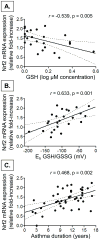Thiol redox disturbances in children with severe asthma are associated with posttranslational modification of the transcription factor nuclear factor (erythroid-derived 2)-like 2
- PMID: 21514635
- PMCID: PMC3105207
- DOI: 10.1016/j.jaci.2011.03.031
Thiol redox disturbances in children with severe asthma are associated with posttranslational modification of the transcription factor nuclear factor (erythroid-derived 2)-like 2
Abstract
Background: Airway thiol redox disturbances, including depletion of the antioxidant, glutathione, are differentiating features of severe asthma in children.
Objectives: Given the role of the transcription factor nuclear factor (erythroid-derived 2)-like 2 (Nrf2) in maintaining glutathione homeostasis and antioxidant defense, we quantified expression and activity of Nrf2 and its downstream targets in the airways and systemic circulation of children with asthma. We hypothesized that Nrf2 activation and function would be impaired in severe asthma, resulting in depletion of thiol pools and insufficient glutathione synthesis and conjugation.
Methods: PBMCs and airway lavage cells were collected from children 6 to 17 years with severe (n = 51) and mild-to-moderate asthma (n = 38). The thiols glutathione and cysteine were quantified, and expression and activity of Nrf2 and its downstream targets were assessed.
Results: Children with severe asthma had greater oxidation and lower concentrations of glutathione and cysteine in the plasma and airway lavage. Although Nrf2 mRNA and protein increased in severe asthma as a function of increased thiol oxidation, the Nrf2 expressed was highly dysfunctional. Nrf2 activation and downstream targets of Nrf2 binding, including glutathione-dependent enzymes, were not different between groups. The duration of asthma was a key factor associated with Nrf2 dysfunction in severe asthma.
Conclusion: Children with severe asthma have a global disruption of thiol redox signaling and control in both the airways and systemic circulation that is associated with posttranslational modification of Nrf2. We conclude that the Nrf2 pathway is disrupted in severe asthma as a function of chronic oxidative stress, which ultimately inhibits glutathione synthesis and antioxidant defense.
Copyright © 2011 American Academy of Allergy, Asthma & Immunology. Published by Mosby, Inc. All rights reserved.
Figures








